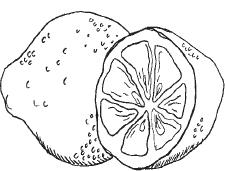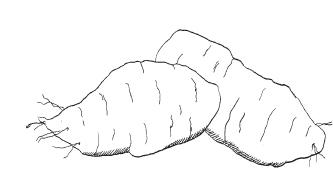Nourishing Traditions: The Cookbook That Challenges Politically Correct Nutrition and The... (161 page)
Authors: Sally Fallon,Pat Connolly,Phd. Mary G. Enig
Tags: #Non-Fiction, #Reference, #Science, #Health

GRAPE COOLER
Makes 5-6 quarts
This delicious and refreshing drink is an excellent substitute for wine, containing all the nutrients of grapes found in wine, including many enzymes, but none (or at least very little) of the alcohol.
Remove grapes from stems, wash well and pass through a juicer. Place liquid in a large bowl with salt and whey and stir well. (Reserve pulp to make natural yeast bread,
Natural Yeast Bread
). Cover with a cloth and leave at room temperature for 3 days. Skim off any scum that may rise to the top and strain juice through a strainer lined with a tea towel. Store grape cooler in airtight glass containers in refrigerator. Delicious flavors will develop over time. Best served diluted—half water, half grape juice.The sediment will fall to the bottom of the containers and should remain there if the grape cooler is poured out carefully. However, you may also filter the cooler again by pouring it through a strainer lined with a tea towel.
Fruits contain protective substances, above all fiber and vitamin C. Berries (strawberries, raspberries, blackberries, gooseberries and cassis) are particularly rich. Grapes contain a phenol—ellagic acid—that reduces the effects of carcinogens. Johanna Brandt, author of a well-known book, cured herself of metastasized cancer with grapes and fasting. Her book contains numerous testimonies of other cancer victims who were cured by her method. Claude Aubert
Dis-Moi Comment Tu Cuisines
In an American Cancer Society study of 78,000 women, those who consumed artificially sweetened foods gained more weight over a one-year period than those who consumed sugar sweetened products. In another study students were hungrier after drinking artificially sweetened liquids than sugared ones. If sugar is a substitute for "the sweet experience," then artificial sweeteners are a substitute for a substitute. It's like using counterfeit money to buy fake diamonds. David Marc
Nourishing Wisdom

Know Your Ingredients
Name This Product #48
Water, sucrose, glucose syrup solids, citric acid, natural lemon flavor with other natural flavors, salt, sodium citrate, mono-potassium phosphate, caramel color, ester gum, brominated vegetable oil.
See
Appendix B
for Answer
PUNCH
Makes 2 quarts
juice of 6-8 lemons
½ cup Rapadura (see
Guide to Natural Sweeteners
)½ cup whey
Whey and Cream Cheese½ teaspoon grated nutmeg
2 quarts filtered water
Punch comes from the Hindu word meaning "five," because it was made with five ingredients. During colonial days in America, the five ingredients were water, sugar, lemons, tea and liquor. The earliest description, in a poem thought to have been written by Samuel Mather in 1757, calls for water, sugar, lemon juice, grated nutmeg and a small amount of "spirit." We substitute Rapadura (which was the type of sugar used in India) for sugar and whey (which would have been readily available in India) for "spirit." The result is a delicious nonalcoholic fermented drink—a kind of Hindu lemonade.
Place all ingredients in a 2-quart glass container. Cover tightly and leave at room temperature for 2-3 days. Skim off any foam that may have risen to the top. Cover tightly and refrigerate. The punch will develop more flavor over time.
You can eat a diet that has no enzymes and still live for many years, even to ripe old age, though each generation you would produce inferior offspring; and, eventually, reproduction would be impossible. Would it not be better to let outside enzymes do some of the work and save your own enzymes for cellular work? Is it possible that cellular enzyme exhaustion is the root cause of what ails us? Victoras Kulvinskas
Introduction to Food Enzymes for Health and Longevity
ROOT BEER
Makes 2 quarts
3-4 cups sassafras root shavings
¼ cup whey
Whey and Cream Cheese1 teaspoon sea salt
½ cup Rapadura (see
Guide to Natural Sweeteners
)¼ cup molasses
½ cup fresh lime juice
½ teaspoon coriander seeds, crushed
¼ teaspoon ground allspice
filtered water
Sassafras, with its distinctive root-beer-like smell, grows all along the eastern seaboard. You'll need to dig up a piece of root and turn it into coarse shavings. Homemade root beer made from the root, rather than an extract, has little resemblance to syrupy sweet commercial varieties. Its taste is somewhat medicinal but not unpleasant. You may wish to dilute it with sparkling mineral water.
Place shavings in a pan with about 4 cups of filtered water, bring to a boil, reduce heat and simmer about 2 hours. Strain into a measuring cup. You should have about 1 cup of sassafras concentrate. Let cool and combine with remaining ingredients in a 2-quart glass container, adding enough filtered water to make 2 quarts. Cover tightly and leave at room temperature for about 2 days. Transfer to refrigerator for several weeks before serving.
Sassafras was one of America's first export crops, a bigger seller than tobacco in the 17th century. Its leaves are in season from spring to fall, but the root is edible all year long. The Indians valued infusions of sassafras root for the blood and as a traditional spring tonic. American colonists and Europeans used it to treat a long list of complaints including arthritis, gout, colds, fevers, blood pressure, urinary problems, kidney stones, eczema and other skin disorders and intestinal problems. Safrole, an ester derived from the root, was valued for menstrual discomfort and the pain of childbirth.
When research showed that astronomical quantities of artificial safrole caused cancer in rats, the U.S. Food and Drug Administration had a convenient excuse for removing sassafras from health food stores. One suspects that the FDA was more concerned about eliminating competition for the drug and soft drink industries than in protecting the populace from a carcinogen. Americans had enjoyed sassafras as a tea and in root beer with no ill effects for centuries. SWF
SWEET POTATO SODA
(Fly)
Makes 1 gallon
2 large sweet potatoes
1 tablespoon mace
1 gallon filtered water
2 cups Rapadura (see
Guide to Natural Sweeteners
)½ cup whey
Whey and Cream Cheesegrated rind of 2 lemons or 3 limes
juice of 2 lemons or 3 limes
pinch of nutmeg
pinch of cinnamon
2-3 cloves
2 egg whites
pinch of salt
shells from 2 eggs, crushed
This interesting fermented drink comes from Guyana. Place mace and 1 cup filtered water in a pan, bring to a boil and allow to cool. Meanwhile, peel and grate sweet potatoes. Place in a strainer and rinse well with running water. Place sweet potatoes, boiled mace, Rapadura, whey, spices, remaining water and rind and juice of lemons or limes in a bowl and mix well.
In a clean stainless steel or glass bowl, beat egg whites with pinch of salt until stiff. Fold in crushed egg shells and spread gently on top of the liquid. Cover with a cloth and keep at room temperature for 3 days. Pour through a strainer into glass containers, cover tightly and store in the refrigerator.
The world today relies on just one hundred fifty food plants, and only twenty of those produce 90 percent of our food. Nine are widely used and account for three-quarters of the human diet. Of these, just three—rice, corn and wheat—account for half. These are truly slim pickings, considering that there are thirty thousand to eighty thousand edible plants. . .. ninety percent of the people who have ever lived were hunters and gatherers who spent just about three weeks a year collecting a year's worth of grains. Wild food was abundant and people were not. The diet was truly diverse. People grazed on three thousand to five thousand plants. The biologist Gary Naghan estimates that Native Americans in the Southwest regularly sampled eleven hundred plants. . .. A second Green Revolution is at hand; but this time it is a Green Gene Revolution, a bioengineered food system based on the ingredients of privatized germ plasm and the menu of monopoly. Poised on the two-headed cusp of the biotechnology revolution, the seed genetics industry comprehends the depth of public controversy it could provoke. Scientists are reporting to work today at the gene bank and the cell library. Using tissue culture technology, they take cellular samples of a plant and grow it out in the laboratory. They cook up large batches of plant embryos and bathe them in liquid fertilizers and pesticides. Then they ready them for sale to farmers and gardeners, eliminating all the chancy, costly, time-consuming vagaries of agriculture and seed production. . .. The Green Gene Revolution is mutating from monocultures to clonal cultures. Entire fields will be planted in monocultures of identical clones derived from the cell tissue of a single plant, chemical fed and lab bred. Kenny Ausubel
Seeds of Change

HAYMAKERS' OAT WATER
Makes 1 gallon
1 gallon filtered water
1 cup rolled oats
1 cup lemon juice or raw apple cider vinegar
1 cup molasses (optional)
Mix all ingredients and keep at room temperature several hours or overnight, stirring occasionally.
GINGER BEER
Makes about 8 quarts
14 teaspoons ground ginger
14 teaspoons white sugar
filtered water
3 cups Rapadura (see
Guide to Natural Sweeteners
)juice of 4 lemons
